Archontophoenix alexandrae



Leaf scars or bases
Persistent leaf bases attached to the trunk or leaf scars that remain on the trunk.
Standard
A plant with a free standing erect stem and terminal foliage.This solitary feather palm has a slender greyish trunk that is strongly swollen at base and a spreading crown of graceful dark green fronds. It has a smooth green crown shaft and the creamy white flowers appear in a pendant cluster during summer.
Archontophoenix alexandrae (F.Muell.) H.Wendl. & Drude, is naturally found in Australia growing on the northern east coast of Queensland from the tropic of Capricorn to Cape York. It grows along water courses in rainforest or lowland swamps on the coast and inland from sea level to an altitude of 600 m (1,968 ft). It is also cultivated as far south as Nowra in New South Wales singularly or in groups. It prefers a well drained organic rich moist-wet sandy loam that is slightly acidic with a pH range from 6.0 - 7.5. It grows in an open to protected semi shaded to sunny humid position and is frost and drought tender but tolerates inundation, heat and humidity.
The Alexandra Palm is grown for its stately habit and is planted in tropical gardens or along water courses singularly or in groups. It is suitable for coastal and low-mountain regions, establishing in 3 to 5 years. It is also used for riverbank binding and when young it can be grown in pots and tubs requiring ample light and humidity, but is not suitable for indoor culture. Once established it has a medium water requirement, (Scale: 2-drops from 3) preferring organic rich deep soil that is reliably moist and tolerates periodic inundation.
I.D. 418
UK hardiness zone H3
Climate zones 21 - 24
USDA Zone 10-12
Archontophoenix (ar-kon-toh-FEE-niks) alexandrea (alex-an-dree-a)
"Archontos", from the Greek word for "chieftan"; "phoenix", a Greek name for a date palm (thus: "ruler of palms" - referring to its majestic habit); "alexandrae" commemorates Princess Alexandra of Denmark, who was later Queen Dowager of Great Britain.

Arecaceae (ar-ek-AY-see-ee)
(Palmae)
Palm Family
This family consists predominantly of tropical monocotyledons that form climbing and tree like habits with divided pinnate leaves and axillary inflorescence that produce ample indehiscent fruit.
Distribution
These plants are mainly distributed in tropical and warm temperate areas of the world from Central and South America to the Malay Peninsula and Africa in environments with poor drainage or permanent water such as mangrove swamps and low land rainforest. A small number of species are found in temperate regions.
Diagnostic Features
Palms are long lived and form solitary or multiple trunks that are rarely branched and can form a clump of, rarely with underground stems. They have a single apical bud and if it is killed by frost or mechanical damage the stem dies.
The leaves (fronds) of adult plants appear in regular numbers per stem at the apex with their tubular leaf bases clasping around the stem. These forms a pseudo-stem (crown-shaft) as in Arecoid palms or the dead leaf bases form a parchment-like weaved mat and may split below the petiole. The distinctive petiole is armed or unarmed with spines or teeth and leaf scars or leaf bases may be persistent on the trunk. They vary in size from 150 mm (6 in) to 25 m (82 ft) in length.
The leaf blade is plicate from bud and is normally simple and adult fronds are palmately, pinnate and occasionally bipinnate with pinnate ribs. Caryota spp. is palmately lobed simple with ribs and appears compound with the petiole acting as the rachis (Costapalmate). All have ligula terminating the petiole and have leaflets that fold upwards then down wards to the petiole or rachis and have one to several parallel nerved veins joined by transverse veinlets.
The inflorescence is simple or branched into a huge panicle and normally arises from the leaf bases and forms with a protective overlapping woody bracts that remains until the flowers developed.
The numerous small flowers occur individually or 2 - 3 together in a cluster and are monoecious or dioecious with the perianth segments in 2 whorls. The female flowers are generally 3 merious with 3 somewhat imbricate sepals and petals and have 3 stamens.. Male flowers sometimes have 4 petals and sepals. The flowers of pollinated by wind, ants, bees, beetles and flies.
There are three or more stamens and sometimes are adnate to the perianth or have the filaments joined into a tube or disk.
The gynoecium normally three-carpelled and may be fused or unfused. The ovary is superior with 3 carpels that have a single ovule and in many species only one ovule per flower that matures into one seed. The styles are rarely elongated and normally the arrangement is a three lobed fleshy stigma that is sessile on the ovary.
The fruit normally contains a single seed and it is a drupe or berry with a woody or fibrous surface that is smooth, prickly or hairy mesocarp is fleshy or dry and rarely produced 2 - 10 seeds.
The indehiscent seeds are commonly brightly coloured and have endosperm that is oily or fatty and a hard coated.
Note:
The palms have many uses from making spears to the fruit and leaf bases being eaten. There are of great horticulture importance and are used in many gardens.
This plant tolerates between USDA zones 10a to 12a and grows to 28 m (70 ft)
Fahrenheit 30º to 55º F
These temperatures represent the lowest average
Celsius -1.1º to 12.7º C

Attention
The information displayed on this plant is based on research conducted in our horticultural library and from reliable online resources. We also make observations of the plant that we photograph, and all care is taken to ensure the details are correct.
All photographs and data are covered by copyright. Apart from any fair dealing for the purpose of private study, research, reference or review, as permitted under the Copyright Act, no part including images and text may be reproduced by any means without written permission. The information presented in the map is only indicative and may contain errors and omissions. All inquiries should be addressed to sales@plantfile.com attention Peter Kirkland.

Compound
The leaf that is divided into separate units (leaflets).
Imparipinnate
A compound leaf that ends with a terminal leaflet.
Spiral
Leaves arrangment is twisted like a screw.
Entire
A leaf margin with no irregularities (smooth).
Cyathiform
A cup like shape.
Panicle
Branched with large loose clusters.| Jan | Feb | Mar | Apr | May | Jun |
| Jul | Aug | Sep | Oct | Nov | Dec |
The semi pendant branched inflorescence appears under the crown shaft and is enclosed in large bracts up to 450 mm (18 in) long that fall away as flowering commences. The 2 male and 1 female flowers are arranged spirally on the branchlets and have 3 petals and sepals.
Note:
The female flowers have imbricate petals and 3 sterial stamens.

Berry
A fleshy succulent indehiscent fruit, contains one or more seeds"| Jan | Feb | Mar | Apr | May | Jun |
| Jul | Aug | Sep | Oct | Nov | Dec |
The pink-red ellipsoid drupe is up to 15 mm (2/3 in) long by 11 mm (3/8 in) wide and has a thin fleshy mesocarp that has interlocking fibers. The seeds are globular and the endosperm is ruminate.
The Alexandra Palm is grown for its stately habit and is planted in tropical gardens or along water courses singularly or in groups. It is suitable for coastal and low-mountain regions, establishing in 3 to 5 years and is also used for riverbank binding. When young it can be grown in containers, but requires ample light and humidity and is not suitable for indoor culture.
Note:
This plant is susceptible to the Giant Locust, Fungal Leaf Spots, Bacterial Wilt (Pseudomonas solanacearum), and Phytophthora Blight.
Young plants require protection from strong sun, as it can burn the leaves and the plant grows vigorously on humus rich moist soils.
Sow fresh seed which will germinate in 6 to 12 weeks if keep warm and moist Seedlings are fast growing and require a deep container.
Palm Seed
Palm seed should be sown as soon as possible after collection as the viability period is short, ripe mature fruit is essential. Do not allow the seed to dry out and if placed in a container of water any seed that floats should be discarded. After selecting seeds dust with a fungicide, as they are prone to fungal attack.
A soil mix composed of half peat moss and half perlite is a reliable media and then placed the containers over bottom heat of 28 º C (80 º F) and don't allow it dry out. It may take up to 1 or 2 years for germination of some species this may be accelerated by scarification or soaking the seeds in gibberellic at 1000 ppm for two days.
Propagation by Seed (General)
Germination
In order for a seed to germinate it must fulfil three conditions.
1. The embryo must be alive (a viable seed).
2. The seed must have no dormancy-inducing physiological, physical or chemical barrier to germination; also the seed must be nondormant.
3. The seed must have the appropriate environmental requirements, water, temperature and oxygen.
The interaction between these requirements and dormancy is complex and may lead to different environmental requirements that avoid the dormancy of a seed.
Sowing Seeds in Containers
There are two general methods for germinating seeds.
1. Sowing seeds in a flat or germinating bed, through which seedlings are pricked-out then, transplanted into another flat with wider spacing or directly to an individual pot.
2. Sowing seeds by placing them in to flats with the appropriate spacing or into individual pots.
This method is normally carried out with medium to large seeds such as woody plants and plants that are difficult to transplant.
Seedling production normally occurs in a greenhouse / glasshouse, cold frames and on hot beds.
Method of Seed Sowing
Fine seed is sown in pots or flats that are no deeper than 70 to 80 mm. using a sterilised well-drained media (soil). Fill the container to 20 mm from the top and sprinkle sieved peat to 3 mm depth.
Press the media down level and firm with a piece of timber and then thoroughly moisten.
Mix the fine seed with washed sand and then sow thinly on the surface. These may be lightly covered with sand.
Larger seeds may be covered with media or a hole is dibbled and the seed is placed in the media.
Watering Methods
For watering you may either mist the containers from above or place the container in tepid water and allow the water to raise through the pot to the surface of the media, then drain away and do not fill to the top of the container.
Place a piece of glass over the pot and store in a protected warm environment (glasshouse).
Seeds germinate best in darkness so shade the containers if in direct sunlight.
After the seedlings have sprouted remove the glass and ease the seedlings into direct light.
When the seedlings are large enough prick them out and transplant into larger containers then place them in a shade house to harden off.
Many seeds have different methods of seed preparation for germination such as nicking or cutting the seed coat to allow water penetration, also placing seeds in hot water and allowing it to cool off.
This is particularly important as it is softening the seed coat.
PEST
NAME
White Palm Scale
Phenecaspis eugeniae
ORDER
Hemiptera
FAMILY
Diaspididae
Description of the Pest
The adult females are 2-3mm long, white and pear shaped; males scales are smaller, flat and elongated and covered in a cottony wax, from which the adult emerges as a small, winged insect. They are usually restricted to the undersides of leaves, except during heavy infestations. This is a hard scale that does not produce honeydew.
Appearance and Distribution of the Pest
An Australian and New Zealand pest, commonly occurring in coastal regions.
Life Cycle
This insect has a Hemimetabolous life cycle, ie. When the immature nymphs resemble the adults.
Several generations appear annually.


Period of Activity
May be active throughout the year in tropical to warm temperate areas.
Damage Caused
Sever infestations may cause yellow patches on the upper surfaces of leaves, corresponding to where the scale is sucking sap.
Susceptible Plants
Palms, NSW Christmas bush, Lillypillies, magnolias, viburnums and other woody plants.
Cultural Control
Small numbers may be rubbed off, or treated with a soapy water solution.
Biological Control
No effective biological controls.
Chemical Control
Spray with white oil and, in severe infestations, a contact insecticide.
Note
Always read the label for registration details and direction of use prior to application of any chemicals.
PEST
NAME
Orange Palm Dart
Cephrenes augiades sperthias
ORDER
Lepidoptera
FAMILY
Hesperiidae
Description of the Pest
The adult is a small butterfly with orange and brown patterns on wings 30mm across. Larvae have a pale greenish-cream body, with a hard brown striped head; larvae have chewing mouthparts.
Appearance and Distribution of the Pest
Palmdarts occur in tropical to warm temperate zones, along the north and east coasts of Australia. Two common species are the yellow palmdart (C. trichopepla), found north of the Tropic of Capricorn; and the orange palmdart (C. augiades), found along the east coast as far south as Wollongong.
Life Cycle
This insect has a Holometabolous life cycle, ie. When metamorphosis is observed during the pupal stage.
Period of Activity
Most active from Spring through Autumn although, in tropical areas, they may be active throughout the year.
Damage Caused
Palmdarts are a significant pest to palms. Caterpillars strip the leaves of the palms to the midrib, giving the leaves a damaged appearance. During the day, palmdarts roll the palm frond into a tube, secured by silk, in which they hide.
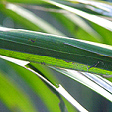

Susceptible Plants
Palms are susceptible, especially Archontophoenix species.
Cultural Control
Unroll the fronds and remove the larvae where possible.
Biological Control
Parasites and birds may reduce numbers.
Chemical Control
Smaller plants may be sprayed with contact insecticides with a wetting agent.
Note
Always read the label for registration details and direction of use prior to application of any chemicals.
PEST
NAME
Cottonycushion Scale
Icerya purchasi
ORDER
Hemiptera
FAMILY
Margarodidae
Description of the Pest
This pest is also known as Ribbed Scale or Bark-louse. The small soft bodied female is oval shaped, reddish-brown, and produces an extended fluted egg sack up to 10mm long that is covered with white, waxy threads. The crawlers are red with dark legs and the adult males are winged. The nymphs infest the ribs and veins of leaves, sucking the sap. Adults and nymphs suck sap with piercing and sucking mouth-parts and ants are attracted to the honeydew produced by feeding nymphs.
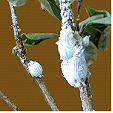
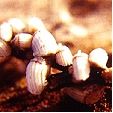 Image by B. Sonsie
Image by B. Sonsie
Appearance and Distribution of the Pest
This insect has a Hemimetabolous life cycle, ie. When the immature nymphs resemble the adults.
Adults appear during the warmer months and infest twigs branches and are found on the trunks of some trees. Ants will usually be present as feeding nymphs produce honeydew, as will the Verdalia ladybeetle, (Rodolia cardinalis), which feeds on the nymphs.
This Australian native insect has been introduced to many countries such as the USA, India, Egypt and South Africa and was only brought under control by the introduction of the Verdalia ladybeetle.
Period of Activity
There are usually two hatches each year, in early spring and late summer.
Susceptible Plants
There are many plants that are attacked by this insect including Australian native species such as Acacia, Eucalyptus, Pittosporum, Hakea and Grevilleas.
Ornamental trees and shrubs are also attacked including fruit trees and citrus, Liquidambar, Salix, Nerium, Magnolia, and Rosa species.
Palm such as Archontophoenix and Howea species are also attacked particularly when grown as an indoor or glasshouse specimen.
Damage Caused
Heavy infestations may cause die-back, particularly where natural predators are absent (eg in glass-houses). The excretion of honeydew promotes sooty mold that restricts the leaves capability to photosynthesize.
Cultural Control
Dead or damaged parts of the plant should be removed and destroyed including fallen fruit. Small infestations may be removed by hand or squashed on the stems. Healthy plants are less susceptible to attack, so maintain vigour of the plant and avoid using high-nitrogen fertiliser that produces excessive soft young growth.
When pruning susceptible plants paint the cuts with antifungal sealant paint as scale insects are attracted to the sweet smell of the sap. This will reduce the infection rate of the plant.
Biological Control
Natural predators such as parasitic wasps may reduce numbers of active nymphs; parasitic wasps are bred commercially in some areas for this purpose and the main natural predator is the Verdalia ladybeetle, (Rodolia cardinalis). It should be noted, however, that wasps would avoid dusty conditions.
Other predators that assist in control are assassin bugs, lacewings, hover flies and scale eating caterpillars. A variety of birds also attack scales.
Chemical Control
Normally not necessary.
PEST
NAME
Grasshoppers and Locusts
Various Grasshopper Species
ORDER
Orthoptera
Description of the Pest
Grasshoppers and locusts are simular but varying in colour. Grasshoppers are a solitary insect while Locusts tend to feed in swarms that vary in size from season to season, depending on climatic conditions. Generally there are two types of insect, one with antennae that are longer than its body (long-horned grasshopper) and are regarded as a solitary feeder. The other insects have short antenna and are known as (short-horned grasshopper) and include species that swarm, examples are below.
The adults may be winged, short-winged with the forewing thicker forming a cover when at rest, or wingless. Some male species can produce sound from special forewings, abdomen and hind legs. They all have enlarged hind legs designed for jumping and are usually well camouflaged.
Nymphs are simular to the adults but smaller and wingless, both have chewing mouthparts.


Australian Plague Locust (Chortoicetes terminifera) is a brown adult short-horned grasshopper with females up to 40mm long and has black markings on the transparent hindwings. The smaller male is simular and both are heavy feeders eating large pieces out of leaves. They are found from tropical to temperate zones forming plagues that migrate and consume all that is in its path.
Giant Locust (Valanga irregularis) is a large brownish short-horned grasshopper up to 80mm long with transparent hind wings and the bright green nymphs do not resemble the adults. Both adults and nymphs feed on leaves, eating large pieces and attacking Palms or Hibiscus species. Common in tropical and sub tropical regions.
Green Gum Tree Hopper (Torbia perfecta) adult is a long-horned grasshopper up to 50mm long with antennae that grow to 60mm in length and has folded flat wings that resemble a leaf. It is a solitary feeder that is found from sub tropical to temperate regions attacking primarily Eucalyptus species.
Katydid (Caedicia olivacea) adult is dark green long-horned grasshopper up to 50mm long and grows antennae to 60mm long. Its wings fold to appear as a leaf and are not easily seen. Commonly a solitary feeder that is found on the coast or inland from sub tropical to temperate regions, and may occur in large numbers feeding primarily on Eucalyptus species.
Migratory Locust (Locusta migratoria) is a brown short-horned grasshopper up to 60mm long and is recognisable by the spiny hind legs and strong looking head, but feeds solitary primarily on Palm species, eating large portions of the fronds. It is found in tropical regions but migrates south with the aid of prevailing wind to sub tropical regions, mainly along the coast.
Appearance and Distribution of the Pest
These insects are found in Africa, Australia, North America, Asia, and Southern Europe. They infest areas by hopping at the nymphal stage or flying with the assistance of wind. They tend to prefer inland regions, but are also found on the coast.


Life Cycle
These insects have a Hemimetabolous life cycle, ie. When the immature nymphs resemble the adults.
Generally the adult deposits up to 30 eggs (egg pod) in the soil during spring, summer and autumn with up to two or more generations per year. The emerging nymphs are called hoppers and there is five stages before the wing buds emerge developing into an adult. The eggs overwinter in a dormant state underground emerging during spring.
Period of Activity
The adults appear during the warmer months of the year. In the dryer areas outbreaks are less frequent though in areas of high rainfall, the outbreaks occur frequently and may turn to plagues.
Damage Caused
Grasshoppers and Locusts are very destructive, singularly and especially in swarms which can defoliate entire fields of corn. The host plant has large pieces of its leaves eaten, the bark is nibbled and almost any part of the plant attacked.
Susceptible Plants
A wide range of commercial crops including corn, wheat, and vegetables. Ornamental shrubs, trees or weeds are also attacked. Certain species are a major pest problem for agriculture.
Cultural Control
It is difficult to control but in early mornings the insects are slow and may be caught and squashed. In a large garden or farms, allow the chooks to free range around the vegetables. They are persistent consumers of the insect. Plants may be covered with a net to reduce access for the insect.
Biological Control
The adult insect is eaten by many birds, predator bugs, lizards and frogs. This helps control small outbreaks but has little effect on swarms.
Chemical Control
It is difficult to chemically control Grasshoppers and Locusts and must be carried out over a wide area and spraying may not guarantee that the crop is not damaged. Bates or traps may also assist in controlling numbers.
Note
Always read the label for registration details and direction of use prior to application of any chemicals.
DISEASE
NAME
Leaf Blight (General)
Various Leaf Blight Species
Description
A fungal problem that attacks the leaves and may spread to other parts.
Symptoms
Generally light to dark brown patches or spots appear on the leaves. These join together causing the leaf to become dried and withered. Infected leaves fall prematurely and dieback occurs in the stems. The overall effect is a sparsely foliaged tree.
On Carrots the fungus (Alternaria dauci) forms small spots that turn the affected area yellow. This can spread over the entire plant resulting in the death of the plant.
Leptosphaerulina Leaf Blight (Leptosphaerulina species) infects Turf Grass. Generally the leaves turn light brown and wilt and from a distance, appear as irregular yellow brown patches. The leaves initially die back from the tip forming water soaked lesions that extend to the sheath and give them a bleached appearance. The fruiting bodies develop on the dead material and the spores are distributed by wind. This fungus appears on many grasses but is only a significant problem for Agrostis palustris (Bent) particularly during hot humid conditions.
Palm Leaf Blight (Pestalotia palmarum) forms grey brown spots on the leaf blades and penetrates into the leaflet axil turning the leaflets brown and killing the frond. Spores appear in black masses on the upper leaf surface. Another Palm Blight (Pestalotia palmicola) infects leaflet tips and progresses down throughout the frond turning it brown.


Strawberry leaf blight (Phomopsis obscurans) infects the leaves primarily with a triangular shaped patch that is reddish turning to brown. It is also found on the petioles and stolons and the tiny black fruiting bodies occur on damaged areas.
The fungal Leaf Blight (Didymascella thujina) forms brownish raised spots on small leaves tuning them brown during late spring and giving them a scorched, dead appearance, eventually falling from the plant during autumn. Commonly found on large Thuja species, but may also attack smaller varieties.
Umbrella leaf blight (Alternaria panax) forms dark brown to black patches that enlarge and distort immature leaves.
Source and Dispersal
The spores originate from other infected trees and are dispersed by wind or infected nursery stock. Once a plant is infected it can moves rapidly throughout. Certain species of tree can tolerate infection.
Favoured Conditions
It prefers humid still conditions with warm temperatures and is particularly a problem in tropical areas.
Affected Plants
A wide range of plants including vegetables, shrubs and trees may be affected.
Hibiscus species leaves are infected by Pellicularia koleroga a soil born fungus.
Leaf Blight (Pestalotia palmarum) infects several palms including Syagrus romanzoffianum and leaf blight (Pestalotia palmicola) attacks Phoenix, Syagrus and Washingtonia species.
Primula species are infected by the Leaf Blight (Phyllosticta prinulicola).
Syringa species are infected with the leaf blights (Cladosporium herbarum) and (Heterosporium syringae) which form large brown spots on the leaves that become dry and fall out.
Tilia species particularly young trees are in infected by the casual fungus (Cercospora microsora), which forms brown spots with darker borders, resulting in the death of the leaf.
Tsuga species are infected by the leaf blight (didymascella tsugae), which turns the leaves brown causing them to fall prematurely.
Non-chemical Control
On small trees remove and destroy the infected parts or in a nursery remove and destroy infected stock. Perennials and annuals should be removed and destroyed. Remove any fallen leaves from around the base of the plant as they contain fruiting bodies.
Chemical Control
Plants may be sprayed at five day intervals with copper oxychloride if possible. Turf infected with Leptosphaerulina Leaf Blight may be sprayed with a broad spectrum fungicide.
Note
Always read the label for registration details and direction of use prior to application of any chemicals.
DISEASE
NAME
Leaf Spot (General)
Various Leaf Spot Species
Description
There is a wide variety of fungal leaf spots that infect perennials, shrub and trees. Some are specific to the host while others can affect a range of plants.
Symptoms
Generally light brown to purplish or blackish spots appear on the leaf and form concentric rings of fruiting bodies. The spots may leave holes, perforating the leaf or expand with pale green to yellowish margins and when the holes merge the leaf normally dies. There are many different types of leaf spot, some are discussed below.
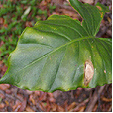 Alocasia species
Alocasia species 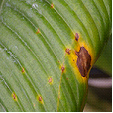
Alternaria Leaf Spot (Alternaria nelumbii) forms a small reddish brown spots that are boarded in light green, and as they develop in size the leaf curls and dies from the margin inwards. Normally occurs on Nelumbo species (water lilies).
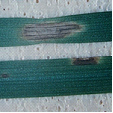 Helminthosporium Disease
Helminthosporium Disease
Helminthosporium Disease (Bipolris species), (Drechslera species) and (Exserophilum species) are responsible for several leaf spots that occur on all Turf Grass species. Generally they form black or white spots that may be faded and produce masses of spores in the thatch during late summer, under humid conditions. The life cycle is short and when conditions are favourable spores are splashed onto the foliage from the thatch, causing wide spread infection. Cynodon dactylon (common couch) is most susceptible and found in bowling or golf greens where it is a serious problem.
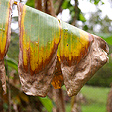 Banana Leaf Spot
Banana Leaf Spot 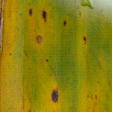
Banana Leaf Spot (Mycosphaerella musicola) is found on many species of banana causing pale yellow streaks on the young leaves to turn brown with dark spots. The leaf then becomes dried, brown and dead commencing from the margins, eventually the leaf dies. Control requires removal of infected foliage or the spraying of a fungicide and fungicides should not be used during the fruiting period.

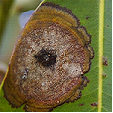 Lophostemon confertus (Brush Box)
Lophostemon confertus (Brush Box)
Leaf Spot on Brush Box (Elsinoe species). This is a casual fungus that attacks the epidermal layer of the leaf, forming circular spots that are up to 25mm across and are often restricted by the main vein. These spots are a dull yellowish brown but can also have purplish patterns. A leaf may have more than one spot develop on its surface and normally appears on scattered leaves throughout the tree. This doesn't affect the vigour of Lophostemon confertus.
Palm Leaf-scab (Graphiola phoeicis) appears as yellow spots and develop into scabs or warts that are outwards hard and dark but with a soft centre with powdery yellowish brown spores. The infected leaves eventually die.
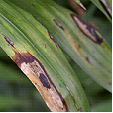 Palm Leaf Spot, Chamaedorea elegans
Palm Leaf Spot, Chamaedorea elegans
Palm Leaf Spot (Pestaloptiopsis species) appears as a small spot with a dark centre on the leaves and affects palms that are growing in shaded humid positions and normally control is not required, though infected fronds should be removed.
Source and Dispersal
Infection source is other contaminated plants and the spores are spread by wind or by splashing water. The fruiting bodies are black spots that appear on the damaged tissue releasing spores.
Favoured Conditions
This fungus prefers a warm humid environment and leafy plants with soft new growth, particularly if they are crowded.
Affected Plants
There are many ornamental and native plants that are hosts to a wide range of fungal leaf spots. Some specific ones are listed below. Plants such as Cornus or Paeonia species are infected by a large variety of leaf spots, while other plants attract a specific leaf spot.
Generally a healthy plant can tolerate fungal leaf spot attack, though it may make the plant look unsightly. In trees and shrubs it is difficult to control and generally not necessary, but in perennials and annuals control may be necessary in order to save the plant.
Acalypha and Arctotis species are infected by up to three leaf spots including (Cercospora acalyphae) and (Ramularia acalyphae) that rarely require control.
Acer species are infected by Purple Eye (Phyllosticta minima) which forms spots with brownish centres and purplish margins causing the death of the leaves.
Acer species are also infected by Tar Spot (Rhytisma acerinum) which forms round black spots that have yellow margins. Not normally seen on cultivated trees, but seen in forests.
Adiantum, Asplenium, Blechnum, Cyathea, Davallia, Nephrolepis, Platycerium, Polypodium and Pteris species are infected by the leaf spot (Pseudocercopora species) which forms circular brown spots on the fronds and heavy infection can defoliate a plant.
Aesculus species are occasionally infected with the leaf spot (Septoria hippocastani) which forms small brown spots.
Agave species are susceptible to the leaf spot (Coniothyrium concentricum), which appear as greyish spots up to 20mm (1in) across with concentric rings and black fruiting bodies. Affected leaves are destroyed as the infection spreads.
Albizia julibrissin is susceptible to the fungal leaf spot (gloeosporium aletridis), which does not normally require control.
Amelanchler, Chaenomeles, Crataegus and Rhaphiolepis species Mespilus germanica are infected by the leaf spot (Fabraea maculata) which may cause considerable damage during wet periods.
Aquilegia species can be infected by three types of Leaf Spot including (Ascochyta aquilegiae), (Cercospora aquilegiae) and (Septoria aquilegiae), normally appearing during humid conditions forming spots on the leaves.
Arbutus species are infected by two leaf spots (Septoria Unedonis) which produces small brown spots on the leaves and (Elsinoe mattirolianum).
Arctostaphylos manzanita is infected by the leave spot (Cryptostictis arbuti) which damages leaves but is not normally detrimental to the shrub.
Aspidistra species are infected by the leaf spot (Colletotrichum omnivorum) causing whitish spots on the leaves and petiole.
Aster species are infected by many leaf spots including (Alternaria species), (Cercosporella cana), ( Ovularia asteris) and (Septoria asteris).
Aucuba species are infected by several leaf spots, usually as a secondary infection after aphid attack. These include (Phyllosticta aucubae) and (Phyllostica aucubae).
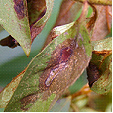
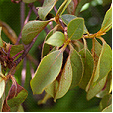 Azalea
Azalea
Azalea (Rhododendron species) are susceptible to Leaf Scorch (Septoria azalea). This fungal disease forms reddish- brown spots which expand and engulf the leaf, with fruiting bodies appearing in the centre. Infected leaves die, then fall and the branchlets wilt. This problem is more serious during wet periods and may require control using a fungicide.
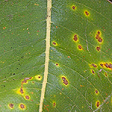 Banksia robur
Banksia robur
Banksia species are infected by several leaf spots causing chlorotic areas that have brown centres and is not normally a major problem for the plant.
Betula species may be infected by the Leaf Spots (Gloeosporium betularum) that forms brown spots with darker margins and (Cylindrosporium betulae) that also forms brown spots with faded indefinite margins.
Bougainvillea species are infected by the leaf spot (Cercosporidium bougainvilleae) which forms rounded spots with dark margins that yellowish ting. Infected leaves die and fall from the plant.
Calendula species are infected by the Leaf Spot (Cercospora calendulae) which rapidly infects the plant spotting the leaves and killing the plant.
Callicarpa species may be infected by the leaf spot (Atractilina callicarpae) forming irregular brownish spot or (Cercospora callicarpae) which can defoliate the plant in subtropical climates.
Campsis species may be infected by several fungal leaf spots including (Phyllosticta tecomae), (Septoria tecomae) and (Cercospora duplicata).
Carpinus species are infected by the leaf spots (Gloeosporium robergei), (Gnomoniella fimbriata) and (Septoria carpinea), all are minor infections not normally requiring control.
Carya species are infected by several leaf spots including (Gnomonia caryae) that infects leaves with irregular reddish spots on the upper surface with corresponding brown spore producing spots on the underside. It also has a secondary spore release that occurs on the dead leaves where it over winters. Other leaf spots include (monochaetia desmazierii) and (Marssonina juglandis).
Ceanothus species are susceptible to the leaf spot (Cercospora ceanothi) and (Phyllosticta ceanothi) both are of minor importance not requiring control.
Celtis species are infected by many leaf spots including (Cercosporella celtidis), (Cylindrosporium celtidis), (Phleospora celtidis) and (Septogloeum celtidis).
Chrysanthemums species are infected by the leaf spot (Septoria species) which forms yellow spots appear toward the edge of the leaves; these become enlarged brownish patches with yellow margins. Damaged areas may converge and in severe attacks and the leaves may fall prematurely or flower production is reduced.
Clematis species are infected by the fungal disease (Ascochyta clematidina) which may cause stem rot or leaf spots that are water soaked areas with reddish margins. The infection spreads from the leaves to the stem causing wilting and eventually girdling the stem killing the plant. There are many fungal leaf spots that infect this plant including (Cercospora rubigo) and (Septoria clematidis)
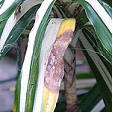 Dracaena deremensis
Dracaena deremensis
Cordyline and Dracaena species may be infected by the leaf spot (Phyllosticta maculicola) which forms small brownish spots that have yellowish margins and has black fruiting bodies that forms coils of spores. These plants are also susceptible to other leaf spots such as (Glomerella cincta) and (Phyllosticta dracaaaenae). Keep foliage dry to avoid infection.
Cynodon dactylon, Pennisetum clandestinum and many other Turf Grasses are susceptible to Helminthosporium Disease.
Daphne species are infected by the leaf spot (Gloeosporium mezerei) and (Marssonina daphnes) both of which form thickish brown spots that are seen on both sides of the leaves. Infected leaves turn yellowish before dieing.
Dendranthema species are infected by many leaf spots such as (Septoria chrysanthemi) which first forms yellowish spots up to 25mm (1in) across that become black. Infected leaves die prematurely and persist on the plant.
Dianthus species may be infected by the leaf spot (Septoria dianthi). It forms light brown rounded spots that have a purplish border. The scattered spots on the lower leaves can also be found on the stems and the spores are dispersed by water from the tiny black fruiting bodies.
Dieffenbachia species are infected by several leaf spot fungi including (Cephalosporium species) and (Myrothecium species).
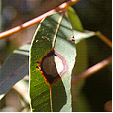 Eucalyptus species
Eucalyptus species
Eucalyptus species are infected by many fungal leaf spots such as (Mycosphaeralla species), (Hendersonia species) and (Monocheatia monochaeta). Generally leaf spots appear on the juvenile or new leaves causing brownish spots that enlarge and may have a purplish halo around the margin. Mature adult leaves are not normally infected and the trees rarely require control measures.
Fern species are infected by the leaf spot, (Alternaria polypodii). This fungus appears as brown circular or oblong spots that congregate along the margins of the pinnae causing the fronds to turn brown and die. It is spread by wind currents from plant to plant and control methods include removing infected fronds and maintaining a drier atmosphere.
Ficus species are infected by various fungal leaf spot including (Pseudocercospora species). Generally the fungal attack forms circular or irregular dark coloured spots on the leaves eventually causing them to fall prematurely.
Ficus elastica is susceptible to many fungal leaf spots including (Alternaria species), (Leptostromella elastica) and (Phyllosticta roberti).
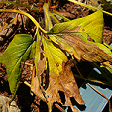
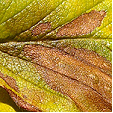 Strawberry
Strawberry
Fragaria x ananassa (Strawberry) is infected by the fungal leaf spot (Mycospharella fragariae). The mature leaf is initially infected with well defined brown spots that that turn light grey with red-purplish margins. As the spots merge they form large brown blotches and the leaf turns yellow then dies. This fungal attack normally occurs on plants in poor health and can be a serious problem early in the season seriously damaging stock.
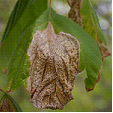 Fraxinus species
Fraxinus species
Fraxinus species are infected by the leaf spot (Gloeosporium aridum) giving the leaf a scorched appearance as large blotches appear from the margin or apex and turn brown with a papery texture. It is more prevalent during rainy periods and infected leaves fall prematurely. Collect and depose of fallen leaves otherwise control is not normally required.
Fuchsia species may be infected by the leaf spot (Septoria species) or ( Cercospora species), both form spots with dead centres and dark margins.
Gladiolus species are infected by Hard Rot or Leaf Spot (Septoria gladioli). On the corms reddish brown circular water soaked spots become large and sunken. These areas dry out and form obvious margins. The leaves may also have these symptoms but is not commonly seen.
Hemerocallis species are infected by several leaf spots including (Cercospora hemerocallis) and (Heterosporium iridis). These may be in the form of black spots or brownish spots that converge killing the leaf. Infected leaves should be removed and burnt.
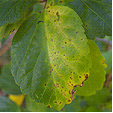 Hibiscus species
Hibiscus species
Hibiscus rosa-sinensis, Hibiscus syriacus and Hibiscus tiliaceus are susceptible to several fungal leaf spots including (Ascochyta abelmoschi), (Cerospora kellermanii) and (Phyllosticta hibiscina). All cause spotting or blotching of the leaf surface; remove and destroy infected parts.
Hydrangea species are infected by four fungal species including (Ascochyta hydrangeae), (Phyllosticta hydrangeae) and (Septoria hydrangeae).
Iris species are infected by several fungal leaf spots including (Alternaria iridicola) and (Macosphaerella species).
Iris species are also infected by the leaf spot (Didymellina macrospore) that forms greyish spots with brown water soaked borders and coalesce on the upper part of the leaf. This casual organism commonly occurs after flowering killing the leaves but will not infect the bulbs. The bulbs become weak over several seasons due to the decreased foliage.
There is also a Bacterial Leaf Spot (Bacterium tardicrescens) that is commonly mistaken as a fungal problem causing translucent spots that coalesce and involve the entire leaf. Normally found on Iris species.
Laburnum anagyroides is infected by the Leaf Spot (Phyllosticta cytisii). The leaf forms light grey spots with no definite margin and mature to brown. The black fruiting bodies appear as dots in the centre of the spot.
Leucanthemum species are infected by the leaf spot (Cerocspora chrysanthemi) and (Septoria leucanthemi).
Magnolia species are susceptible to many species including (Alternaria tenuis), (Mycosphaerella milleri) and (Phyllosticta species). Leaves generally turn brown from the apex or margins turning brown or spots appear on the leaf surface and leaves become yellow before withering and dieing. Normally the make the tree look poorly but have little effect on its growth. Control is not normally required.
Nerium oleander is susceptible to several fungal leaf spots including (Cercospora nerella), (Cercospora repens), (Gloesporium species) and (Phyllosticta nerii). Infected leaves should be removed but generally control is not required.
Nyssa sylvatica is infected by the leaf spot (Mycosphaerella nyssaecola) forming irregular purplish blotches.
Orchids such as Cattleya, Cymbidium, Cypripedium, Dendrobium, Epidendrum, Paphiopedilum, Phalaenopsis and Zygopetalum species are infected by several leaf spots including (Cerospora, Colletotrichum and Phyllosticta species). Normally forming dark or dead, circular or irregular areas on the leaves.
Palms such as Syagrus, Howea, Phoenix, Roystonea and Washingtonia species are infected by Leaf-scab (Graphiola phoeicis).
Palms such as Archontophoenix, Caryota, Chamaedorea, Cocos, Dypsis, Howea, Liculia, Linospadix, Livistona, Phoenix, Ptychosperma, Rhapis, Roystonea, Syagrus, Washingtonia and Wodyetia species are susceptible to several fungal leaf spots including;
(Bipolaris spp.), (Cylindrocladium spp.), (Colletotrichum spp.) and (Pestalotiopsis spp.).
Generally the circular leaf spots are brown and may have a yellow halo such as Palm Ring Spot (Bipolaris incurvata). They vary in size from small to large depending on the species. When a plant is healthy it recovers from attack, but heavy infections can defoliate, causing the collapse of the plant.
Palms are also infected by the Brachybasidium Leaf Spot (Brachybasidium pinangae). This fungus forms angular leaf lesions that produce fruiting bodies on the underside and is commonly found on Archontophoenix species.
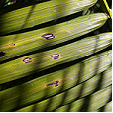
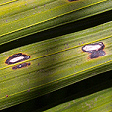 Archontophoenix cunninghamiana
Archontophoenix cunninghamiana
Passiflora species are infected with many types of leaf spot such as (Alternaria passiflorae).
Phoenix species are susceptible to False Smut (Graphiola phoenicis). This fungus forms yellow leaf spots that become hard with a raised with a blackish scab, which produces masses of powdery spores that are thread-like.
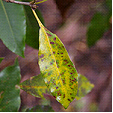
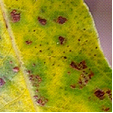 Pittosporum species
Pittosporum species
Pittosporum species are susceptible to the leaf spots (Alternaria tenuissima), (Phyllostica species) and (Cercospora pittospori). Circular or angular dark spots appear on the leaves and are surrounded by necrotic areas that are yellowish. Generally removal of infected leaves is adequate control.
Poa species and other cool season grasses are infected by Winter Fusarium Leaf Disease (Fusarium species), which causes small pale spots that are water soaked to appear on the leaves that turn red-brown. Infected leaves become bleached then wither and die, but the infection will not affect the crown or roots of the plant. It can be identified by pink, cotton-like mycelium and the plant prefers cold wet weather.
Populus species are infected by several fungal leaf spots including (Ciborinia bifrons, Ciborinia confundens), and (Mycosphaerella populicola).
Prunus species are infected by several leaf spots including (Cercospora circumscissa and Septoria ravenelii).
Pseudotsuga menziesii Douglas Fir is infected by the Leaf Cast (Rhabdocline pseudotsugae) Symptoms include the needles becoming yellowish at the apex and extending down the needle and spreading to others during moist spring weather turning them brown. Brownish scorched areas are noticeable on the tree from a distance. Control; is not normally required for mature trees but nursery stock may require spraying with a copper based fungicide.
Psidium guajava (Guava) is infected by (Glomerella cingulate). This fungus courses spots to appear on leaves and mummifies and blackens immature fruit or rots mature fruit. This fungus can devastate a guava crop.
Quercus species are infected by several types of leaf spot including (Cylindrosporium microspilum) and (Marssonina martini). These attacks tend top take place later in the season and normally not detrimental to the tree.
Rhododendron species are infected by a large variety of fungal leaf spots including (Cercospora rhododendri) and (lophodermium melaleucum)
Salix species are infected by several fungal leaf spots including (Ascochyta salicis) and (Septogloeum salicinum).
Senecio species are infected by the fungal leaf spot (Alternaria cinerariae) and (Cercospora species), forming dark rounded or angular spots.
Spiraea species are attacked by the fungal leaf spot (Cylindrosporium filipendulae).
Stenotaphrum secundatum (Buffalo) turf grass is susceptible to Grey Leaf Spot (Pyricularia grisea) in domestic and commercial situations devastating lawns. This fungal disease infects the stems and leaves with small brown lesions that enlarge rapidly forming grey-brown spots that have darker borders or surrounded by yellow chlorotic areas. This infection is commonly found on newly laid turf but will also infect established lawns. It is most prevalent during warm humid periods in soil with a high nitrogen level.
Syringa species are attacked by up to six species of leaf spot including (Cercospora lilacis) and (Phyllostica species).
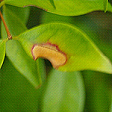 Syzygium species
Syzygium species
Syzygium species are infected by fungal leaf spots but normally control is not required.
Tagetes species are infected by the leaf spot (Septoria tageticola), which starts at the base and moves progressively up through the plant, covering the leaves in grey to black spots.
Trillium species are host to several leaf spots, including (Colletotrichum peckii) (Gloeosporium Trillii) (Heterosporium trillii).
Ulmus species are infected by many fungal leaf spots including (Gnomonia ulmea) and (Cercospora sphaeriaeformis).
Veronica species are infected by the leaf spot (Septoria veronicae). The symptoms include small violet to brown spots appear on the upper surface of the leaf and correspondingly yellowish brown on the underside. The spots converge forming a scorched shot-hole appearance and eventually death of the leaf.
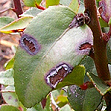 Vaccinium ovatum
Vaccinium ovatum
Vaccinium ovatum is infected by the leaf spot (Rhytisma vaccinii) and (Dothichiza caroliniana).
Vicia species are infected by the leaf spot (Erostrotheca multiformis), which forms greyish spots that enlarge and may defoliate the plant.
Wisteria species are infected by three fungal leaf spots (Phyllostica wisteriae), (Septoria wisteriae) and (Phomatospora wisteriae).
Non-chemical Control
Remove and destroy infected plant material and avoid overhead watering. When planting select infection resistant varieties. Practice crop rotation and add pot ash to the soil to decrease the plants venerability to the disease. Many species of fungus overwinter in fallen leaves, remove and destroy any litter under the plant.
Winter Fusarium Leaf Disease in Turf Grasses can be minimised by aerating the soil, reducing thatch and avoid excessive nitrogen in the soil.
Chemical Control
Protective fungicides such as zineb or copper oxychloride should be sprayed at the first sign of infection and cuttings should be sprayed as they start to grow.
Note
Always read the label for registration details and direction of use prior to application of any chemicals.
DISEASE
NAME
Phytophthora Rot
Phytophthora species
Pathogen Name
A number of Phytophthora species cause these diseases but the most important species in Australia is the cinnamon fungus, Phytophthora cinnamomi. This species is exotic to Australia and probably originated from south east Asia; it has probably been present in Australia for close to 200 years. Phytophthora are fungal-like organisms that are related to some protozoa and algae; they are microscopic and cannot be observed by the naked eye.
Description
There are many types of Phytophthora Rot but generally the disease affects the plant by causing a soft rot of the affected plant part. The most common form of the disease is a rotting of the roots that occurs below ground with no visible symptoms of the disease above ground until the disease starts to cause leaf drop.
Symptoms
The disease is initiated below ground in the soil, usually on the feeder roots of a plant. The pathogen grows through the roots killing cells and eventually causing an extensive root decay. This causes the infected plant to lose vigour and the leaves to yellow and die. Entire branches starting from the top then die, quickly during hot weather or linger for months. The infection occurs on the root hairs causing small and large roots to rot. The symptoms of the disease are often very difficult to differentiate from drought symptoms, mainly because the affected root system prevents the uptake of moisture from the soil. Once the disease has progressed far enough large branches will die causing the typical dieback symptoms.
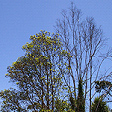
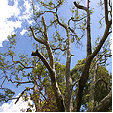
There are a number of other diseases caused by Phytophthora species
Twig Die Back (Phytophthora ilicis) attacks Ilex species causing black leaf spots and black stem cankers.
Phytophthora cactorum is known by several common names depending on which plant is being attacked and they have various symptoms. Plant species are listed below.
Root Rot (Phytophthora richardiae) infects Zantedeschia species causing the leaves to turn yellow, wilt and die. Flowers are deformed if they bloom and the infection can also be seen in the new growth, eventually killing the plant. On inspection the roots show signs of decay.
Stem Rot (Phytophthora cryptogea) infects the roots and stems turning them brown and seeds are also attacked causing decay. It is commonly found on Tagetes erecta and infected plants wilt, collapse and die.
Source and Dispersal
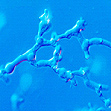 Sporangia
Sporangia 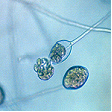 Zoospores
Zoospores 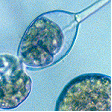
Image by Dr Brett Summerell
Phytophthora species produce sporangia that contain specialised zoospores that have flagella that allow them to move through the soil moisture small distances. These spores encyst on the root and then penetrate the root. The pathogen also produces chlamydospores, specialised survival spores that allow it to survive in the soil for extended periods of time. The chlamydospores can be transported in soil, even extremely small amounts, allowing the pathogen to be dispersed very easily throughout an area and from one location to another. The zoospores are easily moved in water flowing through soil and so are easily dispersed down slopes. It is not uncommon for the disease to move in fronts down a slope.

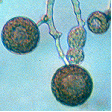 Chlamydospores, specialised survival spores
Chlamydospores, specialised survival spores
Image by Dr Brett Summerell
Favoured Conditions
Phytophthora root rot is favoured by poorly drained soils or in soils that are waterlogged for short periods of time. The disease generally occurs during periods when the temperature is above 16ºC although it has been observed in snow gum country in the Barrington Tops National Park and in southern Tasmania. It also prefers soils that have little organic material.
Affected Plants
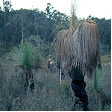
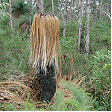 Xanthorrhoea species
Xanthorrhoea species
Image by Dr Brett Summerell
The host range that is attacked by Phytophthora cinnamomi is enormous and is still not well understood but includes many Australian native plants, Rhododendrons, Acer and Prunus species, conifers, cabbage tree and strawberries. Some Australian plant families that are quite susceptible include species in the Proteaceae, Epacridaceae and Xanthorrhoea species.
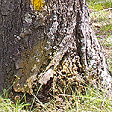 Alphitonia excelsa
Alphitonia excelsa
Alphitonia excelsa can be infected by Phytophthora cinnamomi causing loss of foliage, death of the upper branches and cankers on the trunk.
Cactus such as Cereus species may be infected with Slimy Collar Rot (Phytophthora cactorum) which forms a soft black area at the base of the plant that is water soaked.
Chamaecyparis species may be infected with the Root Rot (Phytophthora lateralis) that attacks roots, trunk, stems and leaves.
Cornus species are infected by Crown Canker (Phytophthora cactorum) and in this case the tree is partially infected initially with one side producing smaller leaves that turn reddish in late summer. The leaves may also shrivel and die prematurely, during dry periods and small and large branches die. After a couple of seasons the tree becomes completely infected with poor top growth and an inconspicuous canker develops at the base of the trunk. Eventually the tree dies.
Erica species are infected by (Phytophthora cinnamomi). The symptoms include foliage turning greyish towards the top, and then the plant wilts then dies with evidence of infection at the base.
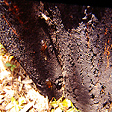 Phytophthora in Eucalyptus species
Phytophthora in Eucalyptus species
Image by B. Sonsie
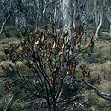
Image by Dr Brett Summerell
Eucalyptus species are infected by Phytophthora cinnamomi causing rapid die back of the tree with blackened trunk loss or upper growth and is a serious problem for certain species such as Eucalyptus diversicolor (Karri).
Euphorbia pulcherrima is susceptible to Root Rot (Phytophthora and Pythium species). Roots become dark and the rot can extend up the stem. The plant is also susceptible to leaf blight resulting from the same fungal disease.
Hedera species are infected by Phytophthora Blight (Phytophthora palmivora). This fungus causes leaf spots, foliage blight and stem rot.
Palms such as Archontophoenix, Caryota, Chamaedorea, Cocos, Dypsis, Howea, Liculia, Linospadix, Livistona, Phoenix, Ptychosperma, Rhapis, Roystonea, Syagrus, Washingtonia and Wodyetia species are also susceptible to Phytophthora Blight forming large irregular areas on the fronds that become dark and rotten and limited by the veins
Lilium species are infected by Foot Rot (Phytophthora cactorum) which attacking the stems just below the soil level causing the plant to topple and if infection occurs as the leaves are emerging the base of the infected leaves which collapse remain attached to the bulb.
Morinda citrifolia is infected by Phytophthora Blight, black flag disease (Phytophthora species) which causes the foliage to turn black and limp. The fruit and stems are also infected causing them to turn brown-black and whither.

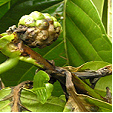 Morinda citrifolia
Morinda citrifolia
Orchids such as Cattleya, Cymbidium, Cypripedium, Dendrobium, Epidendrum, Paphiopedilum, Phalaenopsis and Zygopetalum species are infected by Black Rot (Phytophthora or Pythium species). This causes the leaves, pseudobulbs, rhizomes and roots to form a dark soft rot, normally occurring towards the base of the plant.
Saintpaulia, Dianthus, Gypsophila, Limonium and Anemone species are infected by Root and Crown Rot (Phytophthora nicotianae). This is a fast moving fungus that turns the roots blackish then extends to the crown and petioles causing wet rot of the crown then wilting, eventually killing the plant. When found as Phytophthora Leaf Spot or Blight, angular spots appear with water-soaked margins as in Cordyline and Philodendron species.
Sedum species can be infected by up to three Stem Rot fungi including (Colletotrichum species), (Phytophthora species) and (Pellicularia filamentosa). Commonly occurring in wet soils.
Ulmus and Acer species are also infected by (Phytophthora cactorum) and this is known as Bleeding Canker. This casual disease initially causes cankers in the bark that ooze sap and the sapwood forms reddish lesions with greenish margins. The leaves on affected branches turn yellow, wilt then die and mildly affected trees may survive.
Many species are infected by the Bleeding Canker including Acer platanoides, Acer rubrum, Acer pseudoplatanus, Acer saccharinum, Betula species, Liquidambar styraciflua, Aesculus x carnea, Tilia, Salix and Quercus species.
Non-chemical Control
The most effective control for all Phytophthora diseases is prevention primarily because it is extremely difficult to control Phytophthora diseases after they are established in the plant. As Phytophthora species are most easily transported in infested soil quarantine is an essential component of control of the disease and it is for this reason many areas have hygiene protocols to stop the pathogen being introduced into an area. It is recommended that bush walkers take care not to introduce the pathogen on their boots into un-infested areas and for this reason it is suggested that walking boots be cleaned and preferably sterilised (with 70% methylated spirits) prior to starting a walk.
Cultural techniques such as cultivating the soil regularly with added animal manure and other organic substrates to ensure there is good drainage will also help to minimise the impact of the disease. The plants can be mulched with straw or other organic material taking care that the base of the trunk is left clear. Avoid over watering the soil and observe hygiene in regards to tools, containers or shoes to reduce spreading the infection.
Potting mixes should be pasteurised for 30min at 60ºC to ensure that they are free of the pathogen. It is also very important to grow pots off the ground to prevent the splash of infested mix or water from an infected plant to clean plants.
.
Avoid damaging the bark particularly at ground level and seal any wounds that occur. If cactus or tree species are infected it is possible to cut out the infected area when first seen in order to contain it. Correct tree surgery techniques are required for large trees.
Chemical Control
There are a number of fungicides that are registered for use in the control of these diseases. The most effective chemical control are based on the use of chemicals containing potassium phosphonate. This chemical effectively enhances the defence systems of the plant and has been shown to be most effective in controlling Phytophthora diseases. It is essential that the chemical be applied when the plants is exporting nutrients to the roots, so this is best in the warmer months. The chemical can be applied as a stem injection or a foliar spray, and in some situations as a soil drench. There are specialised stem injecting equipment available for stem injections on larger trees.
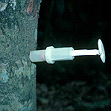
Image by Dr Brett Summerell
Note
Always read the label for registration details and direction of use prior to application of any chemicals.
Amendments by
Dr Brett Summerell
Director Science and Public Programs
Royal Botanic Gardens Trust, Sydney
DISEASE
NAME
Bacterial Rot
Various Bacterial Species
Description
Bacterial problem associated with water soaked strips on the leaves, stem, roots, fruit or flower. Bacterial wilts produce causative slime that clogs the water-conductive tissue of a plant.
Symptoms
Bacterial Blight (Pseudomonas mori) forms water soaked spots on the leaves and shoots, becoming sunken and turning black causing the leaves and twigs to wilt and die.
There is also a Bacterial Blight (Pseudomonas syringae pv pisi) that infects legumes during humid weather with water soaked spots on the leaves and stems near the base. The spots become dark and as the stem shrivels, yellow lesions appear. Leaves and fruit pods turn brown and die.
Bacterial Leaf Spot (Pseudomonas viburni) forms wet spots that enlarge becoming brown and sunken. These spots can be seen on the leaves and young stems and the bacteria overwinter in buds or in cankers. It is found on Viburnum species.
Bacterial Wilt (Xanthomonas species) infects palms causing the lower fronds to wilt then turn grey-brown and die. This is followed by the crown becoming spongy (rotted) attacking the vascular tissues and eventually causing the collapse of the crown. There is also a Bacterial Leaf Spot (Xanthomonas species) that causes spots on leaves with water-soaked margins and is found on Alocasia species.
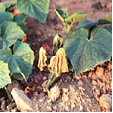 Bacterial Wilt
Bacterial Wilt
Bacterial Wilt (Pseudomonas solancearum biovar 1 and 3). This disease initially turns the youngest leaves pail-green to yellow; they then wilt turn brown and die. It eventually affects the entire plant and is found on Heliconia species.
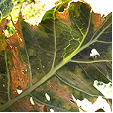
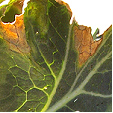 Black Rot or Bacterial Wilt
Black Rot or Bacterial Wilt
Black Rot or Bacterial Wilt (Xanthomonas campestris) is a bacteria rot that infects the leaves and seedlings of Cruciferous vegetables causing 'V' shaped pale yellow blotches to appear, normally infection occurs along the margin of the leaf or through damaged areas of the leaf. It also causes the flower head to become stunted and the veins or water conducting tubes in the leaves and stems to turn brown or blackish. Heavy infections cause the plant to wilt and die.
Bud Rot (Xanthomonas cannae) infects young leaves and flower buds of Canna species, killing them. Small whitish spots appear as the leaves or buds open, these enlarge then run together turning black. The symptoms also extend to the petioles and stems forming yellowish water soaked areas and the bacterium overwinters in the rhizomes.
Halo Blight of Beans (Pseudomonas syringae pv phaseolicola) forms water soaked or greasy angular spots on the pods or stems of the host. This causes the plants to yellow and become stunted. During humid weather a white slime is exuded from the damaged areas.
Soft Rot (Pecotbacterium carotovorum) affects bulbs, initially stops flowers from blooming or forming correctly. These flowers are shed, and the plant rots at the base causing it to collapse. On inspection of the bulbs a white foul smelling viscous smell is associated with a soft rot.
Wetwood (Erwinia nimipressuralis) causes wilting and branch dieback in Ulmus species. The wood forms dark water soaked areas with no obvious streaking in the outer sapwood.
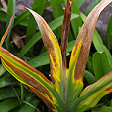 Yellow Rot in Iris
Yellow Rot in Iris
Yellow Rot (Xanthomonas hyacinthi) is a bacterial disease infects the cell walls of the leaf, stem and bulbs and caused yellowish water soaked areas to appear. These areas become brown and shrivel, or pockets of rot appear, soon engulfing the entire bulb. The disease may start from the leaf down or from the bulb up infecting the whole plant. A cross section reveals vascular tissue that is choked with yellowish slime. Infected plants soon brown off, collapse and die.
Source and Dispersal
The bacterium is found in infected plant material and not necessarily the soil and is spread by splashing water, wind or infected stock.
Favoured Conditions
It prefers warm moist conditions normally during spring.
Affected Plants
These bacteria attack many plants including; onions, Hyacinth species and its varieties, this can be a major problem in bulb nurseries.
Vegetables such as potatoes are also infected by blight which forms dark brownish spots on the leaves that become larger, eventually killing them and followed by lesions on the stems. The roots are infected by falling spores and peas suffer from a bacterial blight that forms spongy leaves with dark brown edges. The leaves and stem shrivel and die.
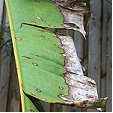 Strelitzia nicolai
Strelitzia nicolai
Archontophoenix and Strelitzia species are susceptible to the Bacterial Wilt (Pseudomonas solanacearum). The leaves become yellowish and brownish along the margins causes the fronds to wilt and dry out. The vascular tissue in the stems then becomes blackish and the plant dies prematurely.
Berberis species are infected by the Bacterial Leaf Spot (Pseudomonas berberidis) forming irregular dark green water soaked areas that turn purplish brown. It also infects young shoots and petioles or damaged areas.
Bougainvillea and Limonium species are infected by the Bacterial Leaf Spot (Pseudomonas andropogonis) which forms orange angular spots that are lighter in the centre and cause the leaves to fall prematurely. It is most common in tropical regions.
Caryota mitis (Clumping Fish Tail Palm) is infected by the Bacterial Blight (Pseudomonas avenea). The symptoms include water soaked translucent areas along the leaf veins that mature to brown then black with a chlorotic halo that is up to 2 mm wide by 50 mm long. Leaves of all ages are infected and immature leaves are more severely infected.
Control methods include eliminating overhead watering, removing infected foliage and improve air circulation around the plant.
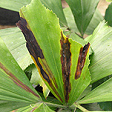 Caryota mitis
Caryota mitis
Cheiranthus species and other plants in the Brassicaceae family are infected by the Bacterial Wilt (Xanthomonas campertris) causing the leaves to wilt, turn yellow and die. It also stunts the inflorescence and turns the phloem and xylem blackish. Other plants that are infected include, Arabis, Armoracia, Aubrieta, Brassica, Hesperis, Iberis, Lobularia and Mathiola species.
Corylus species are infected by Blight ((Xanthomonas corylina) that attacks the leaves and branches.
Delphinium species are infected by several leaf spots including the bacterial disease Black Leaf Spot (Pseudomonas delphinii) which produces irregular tar-like spots on the upper surface of the leaf with corresponding brownish areas on the underside. This infection may extent down the petiole to the twigs. It normally occurs during cool weather affecting the lower leaves first.
Dianthus species are infected by the Bacterial Wilt (Pseudomonas caryophylli) which turns the leaves greyish, then yellowish before dieing. Yellowish streaks are also seen on the stems.
Dieffenbachia species are infected by two Bacterial Leaf Spots (Erwinia species) and (Xanthomonas campestris pv. dieffenbachiae). Both form yellowish spots that turn brown on the leaves that have water-soaked margins.
Eschscholtzia species are infected bt the Bacterial Blight (Xanthomonas papavericola) which forms tiny black spots that are water soaked and may be ringed.
Euphorbia pulcherrima is infected by Bacterial Canker (Corynebacterium poinsettiae) which forms streaks on the green stems that are water-soaked. The leaves may also be affected producing spots or blotches.
Gladiolus, Crocus and Freesia species are susceptible to Bacterial Scab (Pseudomonas marginata). This disease attacks the corms by forming slightly raised yellowish lesions that develops a raised rim with a soft sunken centre, producing bacterial exudate. It also infects the leaves with small reddish spots appearing towards the lower part. These spots merge and destroy the basic cell structure (parenchyma tissue) in the petioles causing the leaves to fold downwards, eventually killing the plant.
Hedera helix is susceptible to the Bacterial Leaf Spot or Stem Canker (Xanthomonas hederae). This infection commences with pale green water soaked spots or areas appearing on the leaves. These areas than become brown-black and dry with reddish margins, eventually engulfing the leaf causing it to shrivel. The bacterium then extends along the twigs and into the stems causing cankers. Several Fungal leaf spots develop simular symptoms and may be difficult to distinguish the difference. Generally avoid high humid temperatures and water plants at the base.
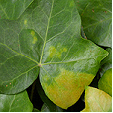
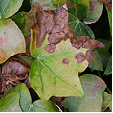
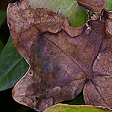 Hedera helix
Hedera helix
Morus species are infected by Bacterial Blight (Pseudomonas mori).
Orchids such as Cattleya, Cymbidium, Cypripedium, Dendrobium, Epidendrum, Oncidium, Paphiopedilum, Phalaenopsis and Zygopetalum species are infected by Bacterial Brown Rot (Pseudomonas cattleya) which forms water-soaked leaf spots that turn brown. Phalaenopsis species are particularly susceptible.
Caryota species are susceptible to Bacterial Leaf Blight (Pseudomonas albopercipitans). This disease forms elongated water soaked areas on the fronds that are translucent at first becoming blackish.
Roystonea regia, Cocos nucifera and Phaseolus species are infected by Bacterial Wilt (Xanthomonas species).
Tropaeolum species are infected by Bacterial Leaf Spot (Pseudomonas aptata) forming spots and rotting the leaves. They are also infected by the Bacterial Wilt (Pseudomonas solanacearum) which gains access through damaged roots or through the stomates, causing yellowing, wilting and the death of the plant.
Zinnia species are attacked by Bacterial Wilt (Pseudomonas solanacearum).
Non-chemical Control
Remove and destroy any infected plants. As a preventive measure cultivate the surrounding soil to improve drainage, aeration and minimise weed growth. Do not over water and allow the soil surface to dry before rewatering. When handling the plants pick a dry period and take care to minimise damage.
At first sigh of infection the plant should be removed and disposed off and avoid replanting susceptible vegetables such as peas for up to three years.
Chemical Control
There is no satisfactory chemical control. It is important to take preventive measures.
Note
Always read the label for registration details and direction of use prior to application of any chemicals.
Average Lowest Temperature : 15º C 59º F
USDA : 10, 11, 12
This USDA (United States Department of Agriculture) hardiness zone chart can be used to indicate a plant’s ability to withstand average minimum temperatures. However, other factors such as soil type, pH, and moisture, drainage, humidity and exposure to sun and wind will also have a direct effect on your plant’s survival. Use this chart only as a guide, always keep the other factors in mind when deciding where, when and what to plant.
A plant's individual USDA zone can be found in the Plant Overview.
Climate Description
Tropical
This zone may be affected by the monsoon or have high rainfall periods. Summer temperatures and humid with mild winters.
Frosts and droughts rarely occur. High winds are accompanied with rain.
Plant growth
Tropical native and exotic plants grow well.
| Dictionary | Growth Habit |
| Leaf Type | Botanic Flower Description |
| Leaf Shape | Flower Inflorescence |
| Leaf Arrangement | Fruit Type |
| Leaf Margin | Bark Type |
| Leaf Apex And Bases | Flower Description |